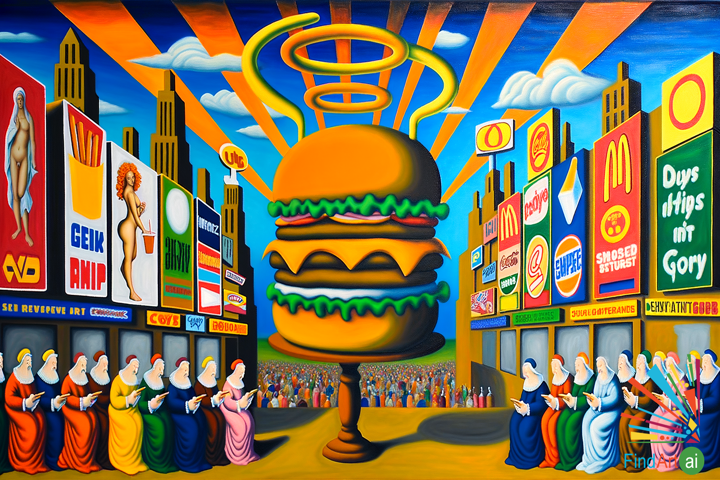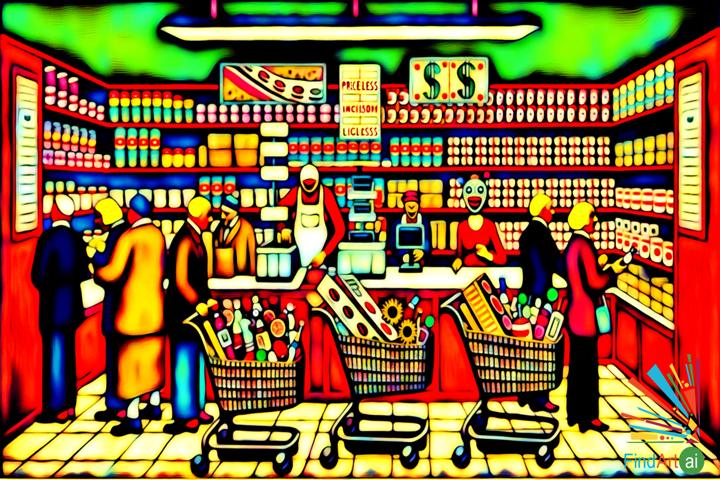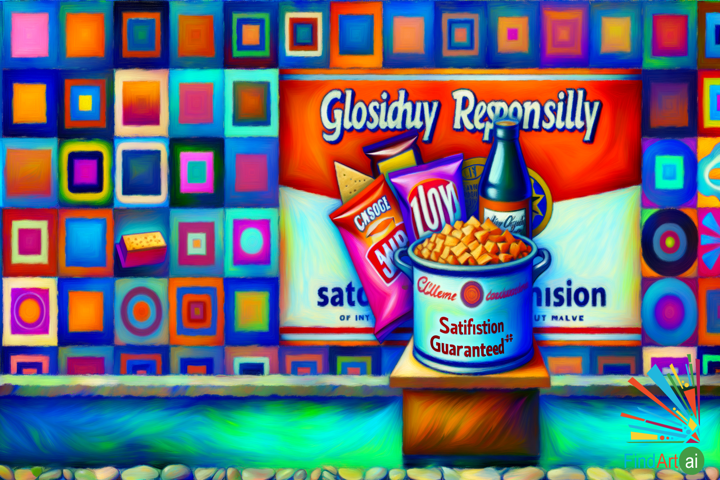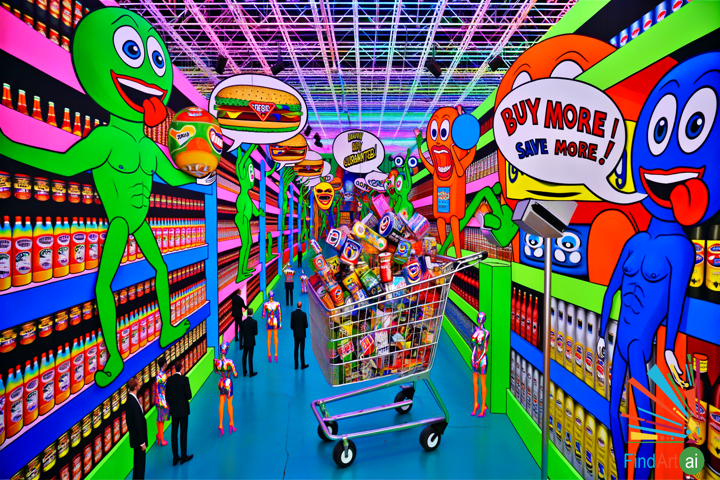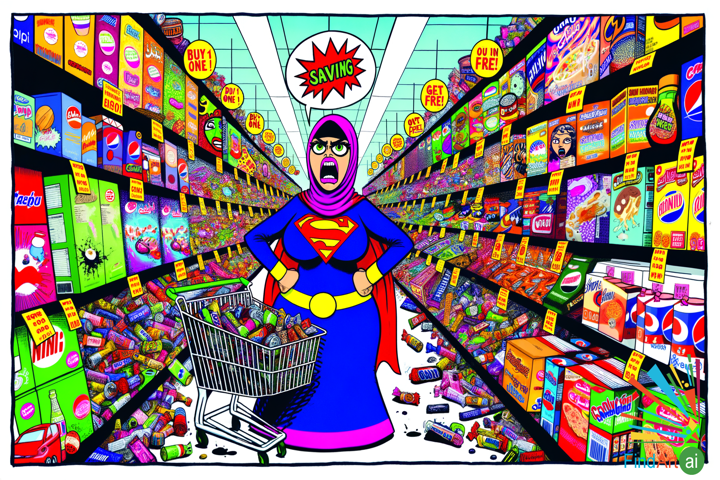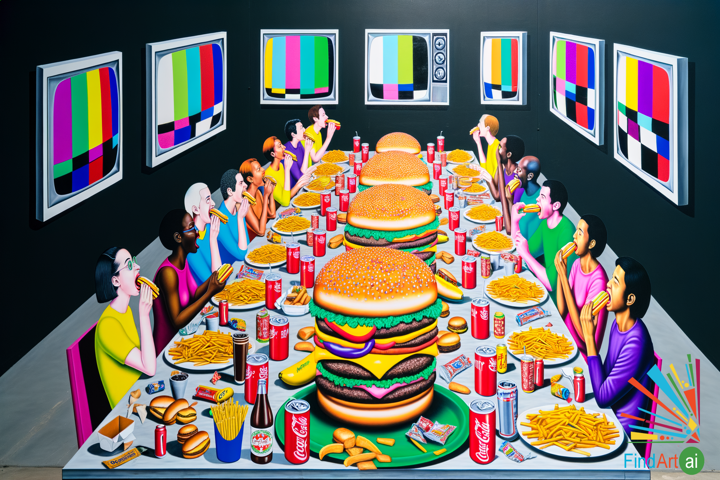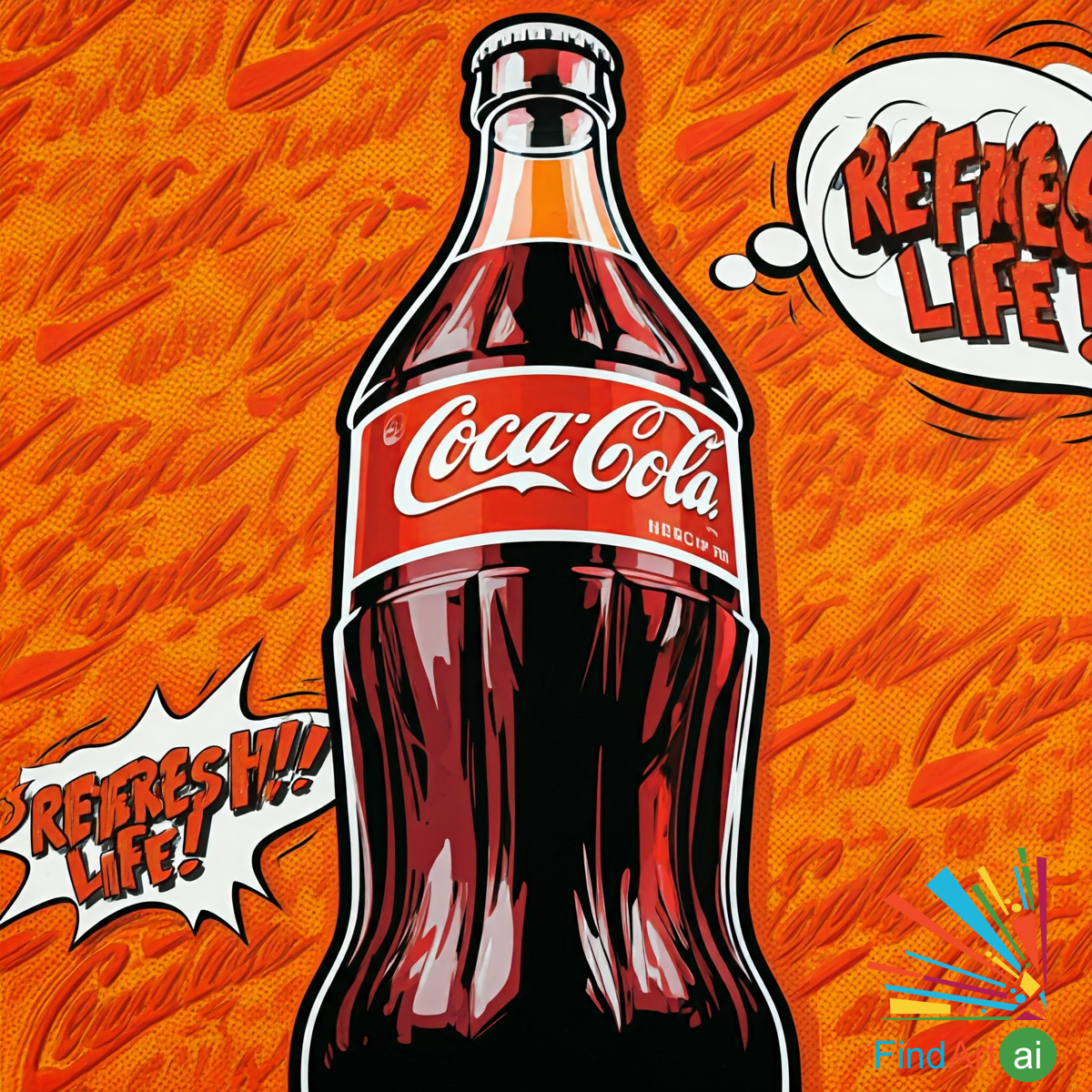
Pop Art Paintings with Irony and Critique Theme
Pop Art paintings with an Irony and Critique theme use mass culture imagery, everyday objects, and consumerist symbols to both celebrate and criticize modern society, often through irony, humor, and exaggeration. Emerging in the 1950s and 60s, Pop Art was a reaction to both the elitism of high art and the rise of mass media and consumerism. Artists within this movement often used familiar imagery—advertisements, comic strips, celebrity icons—recontextualizing them to reveal deeper critiques of consumer culture, materialism, and mass production.
Key Characteristics of Pop Art Paintings with Irony and Critique Theme
- Use of Commercial Imagery
- Pop Art frequently borrows imagery from advertising, product packaging, and mass media to comment on the saturation of consumer culture. By incorporating logos, brand names, and iconic products, the paintings ironically elevate everyday objects to the status of fine art.
- Example: Andy Warhol’s Campbell's Soup Cans (1962), which reproduces the label of a common household product, critiques both the commodification of art and the consumerist society that values such products.
- Bold, Flat Colors and Graphic Style
- Pop Art often mimics the bright, eye-catching style of advertisements and comic books, using flat, bold colors and simplified forms. This aesthetic both critiques the superficiality of mass culture while drawing attention to how visual appeal is used to manipulate consumers.
- Example: Roy Lichtenstein’s Whaam! (1963) replicates the graphic style of comic strips, emphasizing the dramatic and exaggerated emotions typical of mass media, while subtly critiquing its trivialization of violence and heroism.
- Repetition and Mass Production
- Repetition, often through screen-printing or repeated images, critiques the industrial mass production of goods in a capitalist society. By presenting multiples of the same image, Pop Art highlights how consumer goods (and even celebrities) are mass-produced and commodified.
- Example: Warhol’s Marilyn Diptych (1962) uses repeated images of Marilyn Monroe, with some fading and distortions, to critique the way celebrity culture turns individuals into consumable, disposable products.
- Juxtaposition of High and Low Culture
- Pop Art blurs the line between high art and popular culture by incorporating elements of low-brow, everyday imagery into fine art contexts. This juxtaposition often carries an ironic tone, critiquing both the art world’s elitism and society’s obsession with consumer goods.
- Example: Richard Hamilton’s Just what is it that makes today’s homes so different, so appealing? (1956), a collage of mass-produced objects, critiques both the artifice of consumerism and the idealized vision of modern life sold by advertising.
- Parody and Exaggeration
- Pop Art frequently uses parody and exaggeration to poke fun at societal norms, celebrity culture, and the commodification of art. By overstating or distorting familiar images, Pop Art can highlight the absurdity or superficiality of modern consumerism.
- Example: Claes Oldenburg’s Floor Burger (1962), a giant soft sculpture of a hamburger, humorously critiques the consumer culture that glorifies fast food and trivial objects, while commenting on the role of art in transforming the mundane into spectacle.
- Celebrity and Iconography
- Celebrities and icons of popular culture often feature prominently in Pop Art, used as symbols of society’s obsession with fame and surface-level image. While these figures are often glorified, there is an underlying critique of how celebrity culture reduces individuals to commercial products.
- Example: Warhol’s Gold Marilyn Monroe (1962) presents Monroe as a saint-like figure in a golden frame, critiquing both the elevation of celebrities to divine status and the fleeting, disposable nature of fame in a consumer-driven culture.
- Commentary on Media and Mass Communication
- Pop Art often critiques the role of mass media in shaping public perception, focusing on how media distorts reality and manipulates individuals through repetitive and exaggerated messaging.
- Example: James Rosenquist’s F-111 (1964-65), a large-scale collage of fragmented commercial imagery and military symbols, critiques both the consumer culture and its complicity in political and military conflicts, using advertising’s visual language to expose its darker implications.
Common Themes in Pop Art Paintings with Irony and Critique
- Consumerism and Materialism
- Pop Art critiques the pervasive influence of consumerism, exposing how individuals are reduced to consumers and how products become symbols of identity. By using the imagery of ads and products, the artists highlight society’s obsession with material goods.
- Example: Warhol’s Brillo Boxes (1964), where he recreated soap pad boxes as sculptures, critiques how even art can become a commodified, commercialized product in a capitalist society.
- Celebrity Worship
- Pop Art often critiques the idolization of celebrities, exposing how famous figures are commodified and mass-produced just like consumer goods. The paintings suggest a superficial engagement with individuals based on their image rather than substance.
- Example: Lichtenstein’s Crying Girl (1964) critiques the overly dramatic and emotional portrayal of women in comic strips and pop culture, questioning the artificiality of such representations.
- The Superficiality of Modern Culture
- By embracing the aesthetics of mass media and consumer goods, Pop Art highlights the superficiality of modern life, where value is placed on appearances, branding, and mass appeal rather than depth or individuality.
- Example: Hamilton’s $he (1958-61) critiques the objectification of women in advertising and consumer culture, where female figures are reduced to commodities designed for consumption.
- Art as Commodity
- Pop Art often critiques the commercialization of art itself, questioning the boundaries between art and product. By presenting art that mimics commercial products, the artists question the nature of artistic value in a consumer-driven world.
- Example: Warhol’s Dollar Sign (1981), a series of paintings of the dollar symbol, critiques the way art and money are intertwined, exposing the commodification of creativity.
Fast Food Renaissance: Pop Art Masterpiece Fusing History & Modern Consumerism
"Fast Food Renaissance" is a vibrant Pop Art masterpiece blending old-world charm with modern consum...
Consumer's Paradise: Pop Art Critique of Modern Consumer Culture's Extravagance and Emptiness
Consumer's Paradise is a vivid Pop Art piece that exposes the extravagance and emptiness of modern c...
Snack Attack: Pop Art's Colorful Critique of Consumer Culture and Modern Icons
"Snack Attack: The Feast of Modern Icons" is a vibrant Pop Art piece exploring consumer culture's gl...
Consumer Kingdom: A Humorous Pop Art Critique of Oversized Parodies in a Lively Supermarket
"Consumer Kingdom" captures a lively, endless supermarket aisle filled with oversized parodies of po...
Consumer's Feast: A Comic Critique of Materialism in a Colorful Supermarket Adventure
"Consumer's Feast" depicts a lively supermarket aisle teeming with exaggerated, colorful products th...
The Modern Feast: A Satirical Canvas on Consumer Culture and the Chaos of Modern Life
The Modern Feast is a vibrant canvas that satirizes consumer culture. Oversized fast-food items domi...

